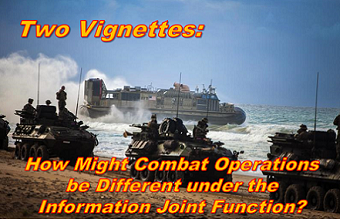[Editor’s Note: We are pleased to welcome proclaimed Mad Scientist Dr. Christopher Paul, RAND Corporation, whose guest post today employs storytelling to illustrate two distinct approaches to Joint Combat Operations. While both vignettes result in the expulsion of adversary forces and the restoration of territorial integrity, the later eschews the wanton destruction of attrition warfare and instead incorporates both kinetic and informational power within combined arms maneuver to force the enemy’s withdrawal, deter future aggression, and preserve the U.S.’s reputation and forces. Read on to learn how integrating cyber and information operations within combined arms maneuver can lead to enduring strategic outcomes!]
Much of the discussion to date on Information as a Joint function is fairly abstract.1 This post seeks to take these strong but abstract ideas and provide a concrete example of what they might mean in the context of a notional and fictional combat operation.
The vignettes below embody two different approaches to the same operation. The first (OPERATION THUNDER HAMMER) is an example of the “as is” condition – an approximation of how the Joint force of today might proceed. The second (OPERATION MALEVOLENT WRENCH) is an example of the “to be” condition–how the operation might be different if conducted while embracing the mindset advanced in the newest Joint function. Note that the capabilities available in each vignette are the same – the major changes are in operational art – the way the Joint force plans, operates, and assesses. These changes lead to subtle but important changes in execution, which can lead to significant changes in the outcomes. The changes in the approach to operational art are: (1) seeking enduring strategic outcomes by identifying the actions and behaviors of relevant actors that lead to those outcomes and then conducting operations with the purpose of influencing those actors to undertake those actions and behaviors; and (2) treating information as a fully integrated part of combined arms operations and leveraging the inherent informational aspects of all military activities.
OPERATION THUNDER HAMMER
Montanyan manipulation of the commodities market sparks an economic crisis in neighboring Centralia. Much of the Centralian population suffers in the downturn, but ethnic Montanyans in the west of the country are particularly hard hit. Demonstrations in the west turn violent (possibly due to Montanyan provocateurs), and Centralian security forces disperse the mobs in a way that is painted as an atrocity 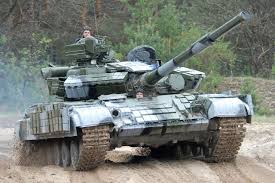 by Montanyan propagandists. Three brigades of Montanyan forces surge across the border in a land grab under the pretext of defending their co-ethnics from imagined injustice and persecution.
by Montanyan propagandists. Three brigades of Montanyan forces surge across the border in a land grab under the pretext of defending their co-ethnics from imagined injustice and persecution.
Centralian forces attempt to fight back but are unprepared and badly overmatched by Montanyan regulars. Centralia appeals to the world for help and UN condemnation of the invasion is swift. The United States is granted authority and designated as the coalition force lead by a UN Security Council resolution. Fearing ethnic cleansing and further entrenchment by the Montanyans, the U.S. president launches a rapid  counter-move supported by responsive international allies. II MEF is designated JFC commanding the combined joint force as part of operation THUNDER HAMMER and ordered to dislodge and push back the Montanyan aggressors and restore the integrity of the Centralia-Montanya border. Forces include 2nd MEB, an available MEU, a carrier battle group, as well as a UK task force built around a Royal Marine Commando Battalion and a French task force built around a battalion from their 9th Light Armored Marine Brigade.
counter-move supported by responsive international allies. II MEF is designated JFC commanding the combined joint force as part of operation THUNDER HAMMER and ordered to dislodge and push back the Montanyan aggressors and restore the integrity of the Centralia-Montanya border. Forces include 2nd MEB, an available MEU, a carrier battle group, as well as a UK task force built around a Royal Marine Commando Battalion and a French task force built around a battalion from their 9th Light Armored Marine Brigade.
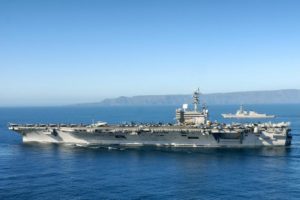 The CJTF’s commander and staff quickly refine their plans while they steam toward Centralia. The COA that emerges from planning includes efforts to engage and fix all three Montanyan brigades simultaneously, with the main effort being a heavy, high tempo drive at the centermost of the Montanyan brigades (the 23rd), supported by forces air-inserted to their rear. Once the Montanyan 23rd is overwhelmed and the two remaining brigades are isolated from each other, CJTF forces will turn the forces that have penetrated the Montanyan line into the flanks of their foe, hitting them hard, breaking them, and hounding them all the way to the border. The commander’s end state includes the defeat of all Montanyan forces and their capture or withdrawal to beyond their own borders.
The CJTF’s commander and staff quickly refine their plans while they steam toward Centralia. The COA that emerges from planning includes efforts to engage and fix all three Montanyan brigades simultaneously, with the main effort being a heavy, high tempo drive at the centermost of the Montanyan brigades (the 23rd), supported by forces air-inserted to their rear. Once the Montanyan 23rd is overwhelmed and the two remaining brigades are isolated from each other, CJTF forces will turn the forces that have penetrated the Montanyan line into the flanks of their foe, hitting them hard, breaking them, and hounding them all the way to the border. The commander’s end state includes the defeat of all Montanyan forces and their capture or withdrawal to beyond their own borders.
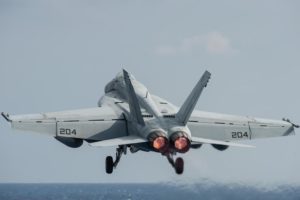 As the operation begins Joint aviation quickly achieves air superiority, though not outright air dominance, especially closer to the Montanyan border where surprisingly sophisticated IADS remain a threat. Much more quickly than the Montanyans could anticipate, the CJTF brings all three enemy brigades under fire and closes with all three.
As the operation begins Joint aviation quickly achieves air superiority, though not outright air dominance, especially closer to the Montanyan border where surprisingly sophisticated IADS remain a threat. Much more quickly than the Montanyans could anticipate, the CJTF brings all three enemy brigades under fire and closes with all three.
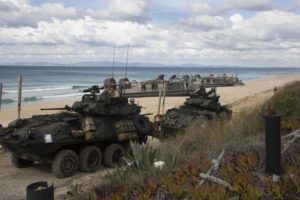 When the attack comes, Joint aviation, naval guns, and Marine and coalition artillery pound all three Montanyan brigades. Using forces previously concealed from the enemy and forces that appeared to be in reserve, the CJTF uses ship-to-shore movement and air mobility to place a substantial force in the rear of the Montanyan 23rd brigade. Before the brigade can reorient, it is pressed hard from both the front and the rear. A fourth brigade of
When the attack comes, Joint aviation, naval guns, and Marine and coalition artillery pound all three Montanyan brigades. Using forces previously concealed from the enemy and forces that appeared to be in reserve, the CJTF uses ship-to-shore movement and air mobility to place a substantial force in the rear of the Montanyan 23rd brigade. Before the brigade can reorient, it is pressed hard from both the front and the rear. A fourth brigade of 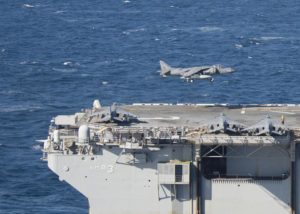 Montanyan forces held in reserve on the other side of the Montanyan border seeks to advance into Centralia to relieve the enveloped 23rd, but Joint aviation brings them under fire, fixing them and closing their main line of advance. IADS lead to mounting airframe losses, unfortunately.
Montanyan forces held in reserve on the other side of the Montanyan border seeks to advance into Centralia to relieve the enveloped 23rd, but Joint aviation brings them under fire, fixing them and closing their main line of advance. IADS lead to mounting airframe losses, unfortunately.
After two days of hard fighting, the 23rd brigade disintegrates, having suffering heavy casualties, massive loss of equipment, and loss of command and control. Pressing the tempo and following the plan, the 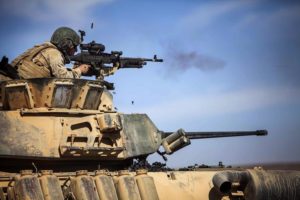 CJTF forces that destroyed the 23rd press the flanks of the two remaining Montanyan brigades. To the south, the Montanyan 66th recognizes its position as untenable and makes a fighting withdrawal toward the Montanyan border under cover of IADS and artillery positioned inside of Montanya. To the north, the Montanyan 22nd finds itself partially enveloped with its line of retreat cut off. The tempo of the CJTF advance caught them by surprise, and they did not recognize their deteriorating position soon enough to change it. Cut off, they fight hard in their defensive positions. As the pressure on the 22nd mounts and they began to disintegrate, remnant elements withdraw into the city of Barrett, the western region’s capital. This leads to bloody
CJTF forces that destroyed the 23rd press the flanks of the two remaining Montanyan brigades. To the south, the Montanyan 66th recognizes its position as untenable and makes a fighting withdrawal toward the Montanyan border under cover of IADS and artillery positioned inside of Montanya. To the north, the Montanyan 22nd finds itself partially enveloped with its line of retreat cut off. The tempo of the CJTF advance caught them by surprise, and they did not recognize their deteriorating position soon enough to change it. Cut off, they fight hard in their defensive positions. As the pressure on the 22nd mounts and they began to disintegrate, remnant elements withdraw into the city of Barrett, the western region’s capital. This leads to bloody 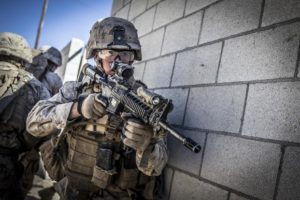 urban fighting as Marine forces are forced to root out the isolated holdouts, some of whom go to ground and will subsequently form the cadre for a separatist guerilla movement.
urban fighting as Marine forces are forced to root out the isolated holdouts, some of whom go to ground and will subsequently form the cadre for a separatist guerilla movement.
The CJTF prevails, having destroyed two Montanyan brigades and driven the third back across the border. The cost, however, is high. The stiff 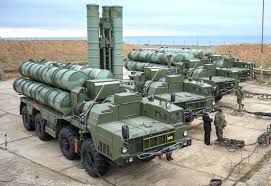 fighting left coalition ground forces severely depleted and Joint air was significantly attrited by IADS. Already economically depressed western Centralia is now war-torn, too. Civilian casualties and collateral damage were high in the tough fighting in and around Barrett. The Centralian government is grateful for the assistance provided by the coalition, but feelings are decidedly mixed among the populace in western Centralia. Montanya moves three fresh brigades to the border region, claiming a need to protect themselves against aggression from Centralia and its “mercenary allies.” Intelligence suggests that Montanya intends to sustain economic pressure on Centralia while pursuing unconventional warfare options to promote discord and sap international will, biding their time for another opportunity to make a bid for annexation of western Centralia.
fighting left coalition ground forces severely depleted and Joint air was significantly attrited by IADS. Already economically depressed western Centralia is now war-torn, too. Civilian casualties and collateral damage were high in the tough fighting in and around Barrett. The Centralian government is grateful for the assistance provided by the coalition, but feelings are decidedly mixed among the populace in western Centralia. Montanya moves three fresh brigades to the border region, claiming a need to protect themselves against aggression from Centralia and its “mercenary allies.” Intelligence suggests that Montanya intends to sustain economic pressure on Centralia while pursuing unconventional warfare options to promote discord and sap international will, biding their time for another opportunity to make a bid for annexation of western Centralia.
OPERATION MALEVOLENT WRENCH
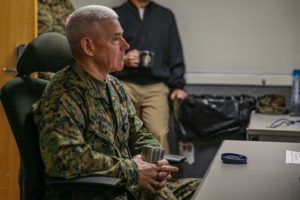
Centralia spirals into conflict exactly as it did in the first vignette, and the UN (and U.S.) response is the same. The CJTF’s commander and staff scramble to understand the situation and make their plans while they steam toward Centralia. The commander believes he has sufficient force at his disposal to destroy the three Montanyan brigades, but not without a heavy cost to his own forces. Before asking his staff to develop and evaluate COAs, he carefully considers his desired end state and how it might relate to enduring strategic outcomes. First, the mission dictates the eviction of Montanyan forces, but does not necessarily require their destruction. Second, whether Montanyan forces are defeated and withdraw or just withdraw intact, he wants future Montanyan aggression to be less likely. Third, he wants to protect the reputation of the United States and the Corps, and to preserve (to the extent possible) the combat power with which he had been entrusted. With this broader set of objectives in mind, he directs his staff to frame the problem broadly, and to gather information about the proclivities and motives of the Montanyan dictator and his brigade commanders, as well as their intelligence and command and control processes.
The COA that ultimately emerges from the planning process emphasizes creating perceptions of isolation and of the untenability of their positions in the Montanyan commanders, forcing them to withdraw, while demonstrating international resolve to the Montanyan dictator. The operation will unfold in a carefully planned sequence, first driving the commander of the Montanyan 22nd brigade to withdraw his forces, then pressing on the 23rd until they withdraw, and then threatening to cut off the Montanyan 56th’s GLOC back to Montanya.
Joint aviation quickly achieves air superiority but not outright air dominance. Much more quickly than the Montanyans anticipate, the CJTF brings all three enemy brigades under fire and closes with all three. Simultaneously, the CJTF, supported by various Joint assets, works hard to degrade Montanyan comms and otherwise isolate 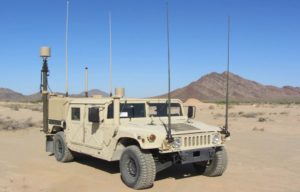 the three formations. Heavy use of cyber operations, electronic warfare, and physical destruction of selected communications nodes are priorities.
the three formations. Heavy use of cyber operations, electronic warfare, and physical destruction of selected communications nodes are priorities.
The CJTF does not yet press the Montanyan positions too closely. Using forces previously concealed from the enemy and forces that appeared to be in reserve, the CJTF uses 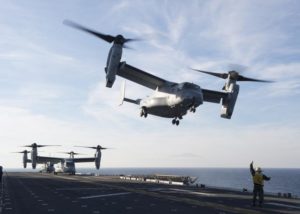 ship to shore movement and air mobility to place a substantial force to the flank and rear of the northernmost Montanyan brigade (the 22nd), intentionally leaving a line of retreat open toward Montanya, but in a blocking position between the 22nd and the Centralian regional capital
ship to shore movement and air mobility to place a substantial force to the flank and rear of the northernmost Montanyan brigade (the 22nd), intentionally leaving a line of retreat open toward Montanya, but in a blocking position between the 22nd and the Centralian regional capital 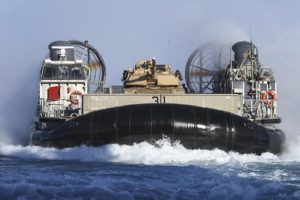 of Barrett. The CJTF commander does not want to risk elements of the 22nd entering the city and creating the opportunity for significant collateral damage or bloody urban fighting.
of Barrett. The CJTF commander does not want to risk elements of the 22nd entering the city and creating the opportunity for significant collateral damage or bloody urban fighting.
The CJTF chose to press on the 22nd brigade because their commander is deemed the most vulnerable to unwitting direction. A thorough estimate concluded that with sufficient attrition from 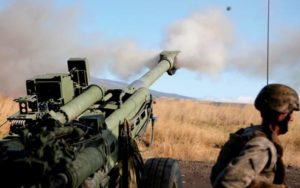 indirect fire, out of communication with his higher headquarters, and in a disadvantageous position (with a substantial unexpected force on his flank), he would likely choose to withdraw to a less disadvantageous position if he believed he could do so. This proves to be the case.
indirect fire, out of communication with his higher headquarters, and in a disadvantageous position (with a substantial unexpected force on his flank), he would likely choose to withdraw to a less disadvantageous position if he believed he could do so. This proves to be the case.
While maintaining a stranglehold on the 22nd’s ability to communicate with the other brigades and with their higher HQ, the CJTF allows the organic ISR assets of the 22nd to take a good look at the formations  massing to their front and flank. These formations then move to demonstrate an advance (an advance that would become real if the 22nd doesn’t shift), which creates an excuse to suspend indirect fires. The CJTF intentionally slows its tempo, allowing time for the commander of the 22nd to observe, orient, and decide what to do. Seeing the two forces closing in on his, knowing the road back to Montanya is open, and fearing that the comms silence means that the other two brigades are similarly beset, the commander of the 22nd
massing to their front and flank. These formations then move to demonstrate an advance (an advance that would become real if the 22nd doesn’t shift), which creates an excuse to suspend indirect fires. The CJTF intentionally slows its tempo, allowing time for the commander of the 22nd to observe, orient, and decide what to do. Seeing the two forces closing in on his, knowing the road back to Montanya is open, and fearing that the comms silence means that the other two brigades are similarly beset, the commander of the 22nd 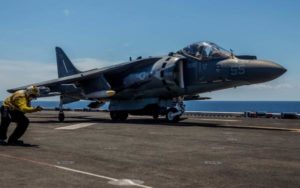 leaves a small rearguard and hastily begins to withdraw the balance of his brigade toward Montanya. Once they are clearly committed to their withdrawal, Joint air and CJTF artillery resume in earnest, ensuring that many of the 22nd brigade’s vehicles are lost in transit along with all of the equipment they abandoned in their initial positions.
leaves a small rearguard and hastily begins to withdraw the balance of his brigade toward Montanya. Once they are clearly committed to their withdrawal, Joint air and CJTF artillery resume in earnest, ensuring that many of the 22nd brigade’s vehicles are lost in transit along with all of the equipment they abandoned in their initial positions.
With the bulk of the 22nd fleeing, the CJTF picks up the tempo again, rapidly encircling and capturing the rearguard and preparing to advance on the 23rd brigade. The disruption of adversary comms is suspended so that all of Montanya (and all Montanyan forces on Centralian soil) can see news broadcasts of the parade of prisoners from 22nd, the heavy equipment of the 22nd abandoned in their defenses, and the celebrations of the crowds in Barrett. The release of footage is selective, however, including no imagery of the highway littered with the burned-out hulks of the destroyed vehicles of the 22nd. It is not in the interest of the CJTF for Montanyan forces to have any misgivings about the safety of retreating.
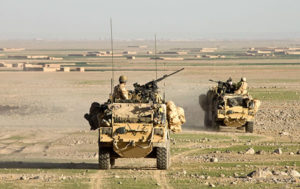
The still largely fresh coalition ground forces, led by British Marines, crash into the front and rear of the 23rd brigade, again carefully leaving a GLOC open for a possible retreat to Montanya. The surprised and demoralized forces of the Montanyan 23rd brigade still give a good accounting of themselves and are pushed back only slowly. This gives way to a more general rout, however, when patchy Montanyan command and control networks began to include partial messages of panic and fragmented orders to withdraw. Though these withdrawal orders are false and were manufactured by the MEF’s information group, they are sufficient to get the demoralized and desperate troops of the 23rd running for home. During their retreat they face a fate similar to that of the 22nd.
With both the Montanyan 22nd and 23rd out of the fight, the CJTF again moderates its tempo, demonstrating a partial regrouping and a partial (and intentionally slow) advance toward cutting off the GLOC to Montanya of the Montanyan 66th. Again, the CJTF intentionally allows Montanyan ISR to observe this movement. The normally reliable commander of the Montanyan 66th sees that he had been abandoned by his comrades and that he is now in danger of being cut off. He sends an aggressive blocking force to prevent the CJTF flanking force from cutting his GLOC with Montanya, and then uses that route for a well-organized withdrawal from Centralia.
 Celebration throughout Centralia is extensive and well publicized. Montanya’s dictator had been humiliated and two of three Montanyan brigades suffered grave losses, while coalition casualties were non-negligible but modest. The CJTF has imposed its will on the Montanyan forces, using physical and informational power as part of combined arms maneuver to drive the Montayans toward actions that were ultimately consistent with the CJTF commander’s end state, including the withdrawal of Montanyan forces, deterrence of future Montanyan aggression, and preservation of U.S. reputation and forces.
Celebration throughout Centralia is extensive and well publicized. Montanya’s dictator had been humiliated and two of three Montanyan brigades suffered grave losses, while coalition casualties were non-negligible but modest. The CJTF has imposed its will on the Montanyan forces, using physical and informational power as part of combined arms maneuver to drive the Montayans toward actions that were ultimately consistent with the CJTF commander’s end state, including the withdrawal of Montanyan forces, deterrence of future Montanyan aggression, and preservation of U.S. reputation and forces.
What is most noteworthy about these two vignettes is what is not different: When the Joint force fights under the mindset of the information Joint function, it still fights, and it still fights to win. It just also fights using integrated informational and physical power at every step to push, herd, lead, guide, coerce, cajole, manipulate, and persuade relevant actors (including adversaries) toward actions (or inactions) and behaviors that are consistent with Joint force objectives, end states, and enduring strategic outcomes.
 Sometimes destruction is the best way to ensure certain future behaviors and sometimes creating perceptions that lead to certain behaviors is the best way lead a foe to destruction. Destruction remains a powerful form of influence. Enduring strategic outcomes, however, often hinge on factors other than the final disposition of enemy forces. The mindset and approach to operational art embodied in the newest Joint function are both a recognition of the possible disconnect between tactical success and strategic success, and an approach to resolving that dilemma. The lesson is to always think about who (relevant actors) needs to be doing what (behavior) in order to enable long-term strategic success and make sure that every aspect of an operation is consistent with those desired effects.
Sometimes destruction is the best way to ensure certain future behaviors and sometimes creating perceptions that lead to certain behaviors is the best way lead a foe to destruction. Destruction remains a powerful form of influence. Enduring strategic outcomes, however, often hinge on factors other than the final disposition of enemy forces. The mindset and approach to operational art embodied in the newest Joint function are both a recognition of the possible disconnect between tactical success and strategic success, and an approach to resolving that dilemma. The lesson is to always think about who (relevant actors) needs to be doing what (behavior) in order to enable long-term strategic success and make sure that every aspect of an operation is consistent with those desired effects.
If you enjoyed this post, check out the following video [access using a non-DoD network] from Dr. Marek Posard and Dr. Christopher Paul‘s webinar on AI and Manufacturing Reality
… as well as the following related posts:
Three Best Information Warfare Vignettes, by Rob Kunzig, Tony Stark, and Davis Ellison
Located, Isolated, and Distracted – An Infantry Platoon Leader’s Experience, by COL Scott Shaw
Weaponized Information: One Possible Vignette
Weaponized Information: What We’ve Learned So Far…
Persistent Disorder Strikes Back – Implications for Future Joint Force Design, by proclaimed Mad Scientist Jeff Becker
>>>>REMINDER 1: You can watch all of the presentations from this Summer’s series of Mad Scientist Weaponized Information Virtual Events here [via a non-DoD network] and explore all of the associated content (presenter biographies, slide decks, scenarios, and notes from each of the presentations) here.
>>>>REMINDER 2: The National Security Innovation Network (NISN) “Seeing Into the Unknown” Virtual Hackathon is now open for your innovative submissions! Click here to read their Hackathon Participation Guide NOW and get your innovative ideas submitted SOONEST!!!
Dr. Christopher Paul is a proclaimed Mad Scientist and senior social scientist at the nonprofit, nonpartisan RAND Corporation where he has conducted research related to information operations, strategic communication, and information-related capabilities for over a decade. He is the lead author of Dominating Duffer’s Domain: Lessons for the Information Operations Practitioner.
Disclaimer: All views expressed in this post are the author’s and do not necessarily reflect those of the Department of Defense, Department of the Army, Army Futures Command (AFC), or Training and Doctrine Command (TRADOC); nor the RAND Corporation.
1 See, for example, the three articles on the information Joint function in Joint Force Quarterly Issue 89, 2nd Quarter 2018.

